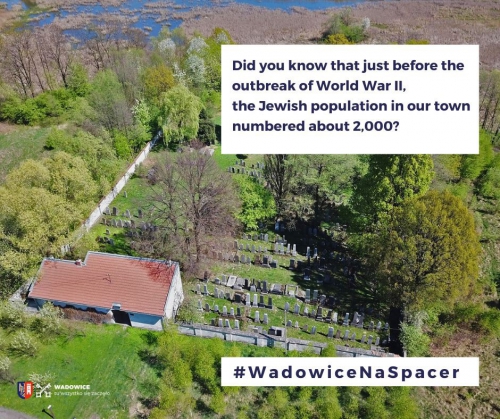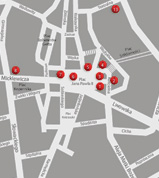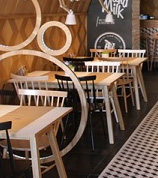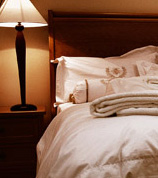
#WadowiceNaSpacer or a Walk in the footsteps of Jews in Wadowice
This time together with #WadowiceNaSpacer, we encourage you to head into town, following the footsteps of the Jewish community in Wadowice. Did you know that just before the outbreak of World War II, the Jewish population in our town numbered about 2,000? In our proposal you will find interesting places, people and stories that create an interesting picture of the community, which was exterminated during the Nazi Germany occupation.
We created a google map that will help you prepare for the route of the walk:
https://www.google.com/maps/d/edit?mid=1wO4VykERN8eamv_FSzSVCkbLkX0-P9A&usp=sharing
- Old synagogue in "Mikołaj", the former land of the voigt – at the junction of ul. Polna and ul. Błonie.
Due to the prohibition on settlement of the Jewish population in the town that lasted until the 2nd half of the 19th century, the Jewish community originally resided in a localities near Wadowice. One such place at the time was "Mikołaj", land of the voigt, located on the outskirts of Wadowice. In this place, a wooden synagogue was built near the mansion house. Its appearance is known thanks to a drawing by Wincenty Bałys. Unfortunately, no information on how long the synagogue was in use remains. Ignacy Krieger (1820-1889), one of the pioneers of photography in Poland, owner of a photographic workshop and author of numerous photographs of the monuments of Cracow was born in the so-called "Mikołaj". Since 1860 he settled permanently in Cracow, where he ran a photographic studio. Krieger expanded his activities in the field of photography on a very large scale; he photographed numerous monuments and mementos of Cracow’s culture and art, as well as immortalized the so-called traditional "human types", i.e. local peasants, Gypsies and Jews in the lens of the camera. Later his works were reproduced on postcards for commercial purposes, as well as used for scientific purposes. After his death, the factory was inherited by his two older children, Natan (1844-1903) and Amalia (1846-1928), maintaining the previously adopted profile of the enterprise.

Fot. Picture Wincentego Bałysa z książki J. Putka, O zbójnickich zamkach heretyckich zborach i oświęcimskiej Jerozolimie [Kraków 1938], from the collection of the Town Musem in Wadowice
- Hass Hotel – Sienkiewicza 24
Constructed around 1900, the building belonged to Wiktor Hass – town councilman, restaurateur and hotelier. In 1938 a religious school for girls of Bais Yaakov was run in this building. Its purpose was to expand the knowledge acquired in the public school with information on Jewish history and culture. The school’s female students also staged Yiddish plays. During the Nazi Germany occupation, Hass ran a canteen for Jews displaced to the established ghetto. After the war, a negligible number of former Jewish residents returned to Wadowice. The first to return were directed to Hass’ hotel, but eventually left the town forever. The only survivor who tried to live as before the war, was Adolf Ebel. He opened his former restaurant, but he too left in 1949. Only one Jew remained in Wadowice – Jakub Szancer.
- Kluger Tenement House – Plac Jana Pawła II 8.
A corner building constructed around 1830, which belonged to the Kluger family since the mid-19th century. On the first floor there was a confectionery store owned by Zachariasz Kluger – a merchant and president of the Jewish Community. On the second floor his son Wilhelm Kluger (the last president of the kehilla) ran a law office. Wilhelm was the father of Jerzy – a friend of Karol Wojtyła. He fought in World War I and the Polish-Bolshevik War. During World War II he and his son were deported to Siberia. In the USSR they both joined General Władysław Anders’ Polish II Corps. After the war he did not return to Wadowice, as almost all of his family (wife Rozalia, mother-in-law Anna and daughter Tesia) perished in the death camps. He left for the United Kingdom and settled in London, where he obtained British attorney’s license and returned to the profession he had practiced before the war.
- The former ghetto – Plac Bohaterów Getta.
With the outbreak of World War II, the decline of the Jewish Community in Wadowice began. After Germans entered the town, they sent young people to labor camps (years 1940-41). Prior to the establishment of a ghetto in the town, all Jews from Kęty, Sucha, Zator and neighboring villages were gathered in the Wadowice. The first instance of their mass deportation from town took place in July 1942. The Jews were divided into three groups. People able to work were sent to work in sheds, those with specific professions were sent to a labor camp in Sosnowiec, while the elderly, cripples and children were sent to Bełżec death camp. Those who remained in Wadowice were confined to the ghetto, which included ul. Mydlarska, ul. Kręta, ul. Piaskowa and the left side of ul. Zatorska. The entire area was surrounded by a wall with barbed wire. There wasn’t enough space for such a large number of people (about 1,400), so shift work was implemented: one half of the population worked, while the other half slept. In may 1943, another action was carried out, during which 100 girls were sent to forced labor in Germany. Almost all of them were saved. In August of that year, the ghetto was liquidated and its inhabitants were deported to the German Nazi concentration and extermination camp Auschwitz-Birkenau. The liquidation of the Wadowice ghetto took place on the 10th of August 1943. At that time some of the Jews managed to escape from it. A small number of them were saved by Poles, who, despite the threat of death, provided assistance to the Jews by hiding them and leading them across the Skawa River to the General Government. Some Jews from Wadowice survived the war in forced labor camps in the Third Reich and in Siberia, where they were deported after the Soviet Union occupied the eastern lands of the Republic of Poland. After the war, a negligible number of former Jewish residents returned to Wadowice. Nowadays there is a market square on the site of the former ghetto and it is called Plac Bohaterów Getta (Ghetto Heroes Square).
- Synagogue - ul. Gimnazjalna 10
The synagogue, in style of modern western ones, was built in years 1885-1889, according to a design by Karol Korn, an architect from Bielsko. It was erected thanks to donations from the faithful and a bank loan, which was being repaid until 1918. It was a tall, T-shaped building in eclectic style with high semicircular windows, crowned with a dome decorated with Decalogue panels. The building with a large courtyard was surrounded by an openwork fence with brick posts. The interior decoration was simple and elegant, with no wall paintings, the ceiling was decorated in stars. Next to the Aron Ha-Kodesh (Torah ark) stood a marble and ebony bimah. The design included a galery for women and a place for the organ, but after the Orthodox came to town, the entrance to the galery was walled off. The synagogue had several hundred seats and standing places. In 1937, a concert by cantor David Kusewicki took place inside it, in which young K. Wojtyła participated. This was probably the first time the future pope crossed the threshold of a temple of another religion. In 1939 the Germans burned down the synagogue, in 1940 the ruins were blown up, and later the remains of the building were demolished. In the 1950s, a kidergarten was built on its site. In 1989 a Polish-Hebrew plaque commemorating the Wadowice Jewish community murdered by the Germans during the war was placed on its wall.

Fot. from the collection of the Town Musem in Wadowice
- Former mikvah – ul. Barska 12
In Judaism, a mikvah is a basin with running water (sometimes a pool) used to achieve ritual purity by persons and vessels. Such washing is performed by complete immersion in the water. Bathing in mikvah also refers to the ritual of accepting a new member into the community. Since the Middle Ages, the term also referred to a bathhouse. In the early days of the community, the mikvah belonged to Izaak Mark and was located on ul. Zatorska. After the construction of two houses of prayer and a cemetery, for budgetary reasons the kehilla left the bathhouse under care of a private person, but under rabbinical control. After World War I, it was sold to a Pole, who didn’t mind rabbinical control, but raised fees for use, limited opening hours or opened it at times that didn’t suit the users. Consequently, the Jews protested, but the Municipality, fearing new debts, did not change the situation. Eventually, under the presidency of Chiel Bałamuth, a loan was taken out and a new bathhouse building was built near the synagogue on today’s ul. Barska. The old mikvah was converted into apartments.
- Former military hospital – ul. Wojska Polskiego 17
Samuel Taub (1869-1933) was the first Jewish doctor in the town. He graduated in medicine from the University of Lviv in 1895. He later settled in Cracow, where he ran his medical practice. After the outbreak of World War I, he received a military assignment to the 20th National Defense Regiment in Stanisławów, which was at the time stationed in Wadowice. He was assigned to the military epidemic hospital at Gościniec Zatorski (now ul. Wojska Polskiego). After the war he remained in Wadowice with his family (his wife Fryda, daughter Norma and son Henryk). He was very well known and liked by the general public for his knowledge and charitable activities. He was also involved in helping the poorest. He was a benefactor of the Wadowice association Bikur Cholim, whose members organized free medical assistance for the Jewish poor. A kind of tribute to his social activities is the epitaph on his grave, which reads "he dedicated his life to the suffering population". He died in 1933 and was buried in the Jewish Cemetery in Wadowice.

Fot. Samuel Taub with wife Fryda and daughter Normą, geni.com
- Jewish cemetery – ul. Wojska Polskiego 52
The efforts to establish the cemetery were started by the Jewish Community as early as 1876. Eventually in 1892 plots of land were purchased for this purpose just behind the military necropolis. At the entrance gate to the cemetery was the Beit Tahara pre-burial house ( house of purification). On the opposite side was the caretaker’s house. Burial issues were handled by the Wadowice religious Brotherhood Chevra Kadisha. In addition to residents of Wadowice and surrounding villages, soldiers of the Jewish faith serving in the local Garrison or those who died in local hospitals were buried in the cemetery. During the Great War, 42 soldiers, most of them serving in Austrian regiments and in the formations of the Hungarian Home Defense, were laid to rest here, and in the years 1919-1920 another 11 people, most of them from the Bolshevik army. The cemetery survived almost intact during the German occupation. After 1945 the cemetery was restored thanks to the Cracow religious community. Currently it is under the management of the Jewish Religious Community in Bielsko-Biała. The last burial took place in 1990.

Fot. Jewish cemetery in Wadowice, Archive of the Wadowice Town Hall.
#Wadowice #GminaWadowice #Żydzi #Spacer #Synagoga #Mykwa #Kirkut #Getto #Kluger #Krieger #Taub

.png)






